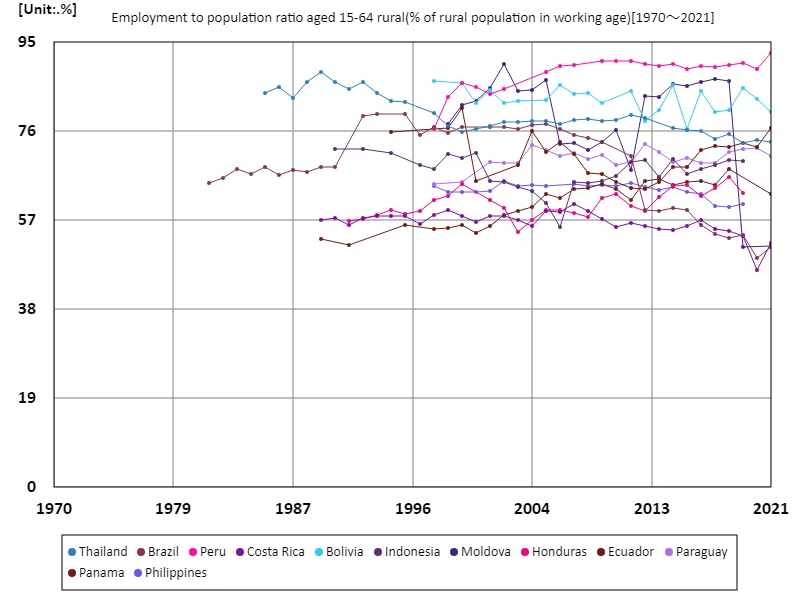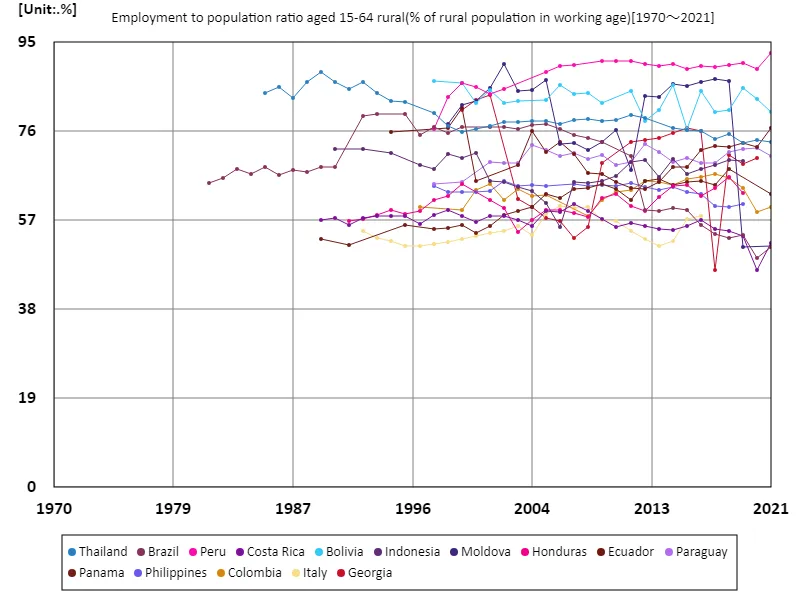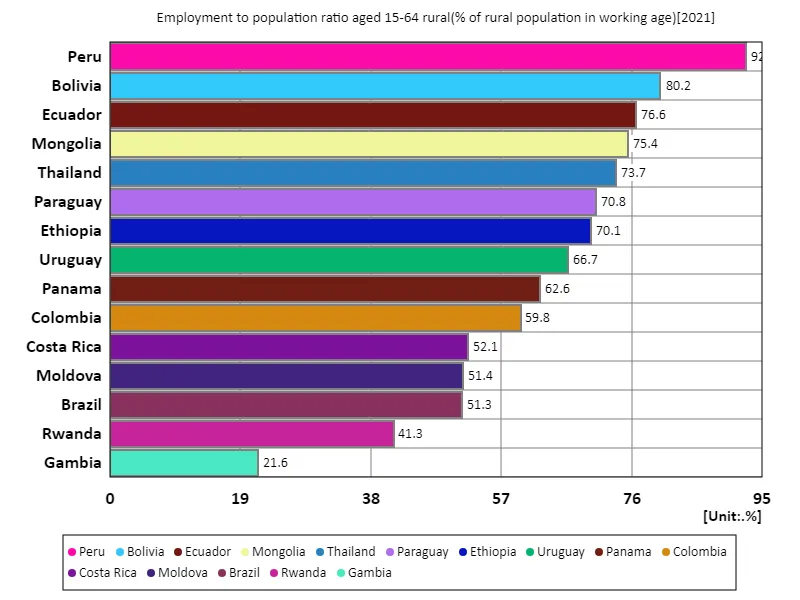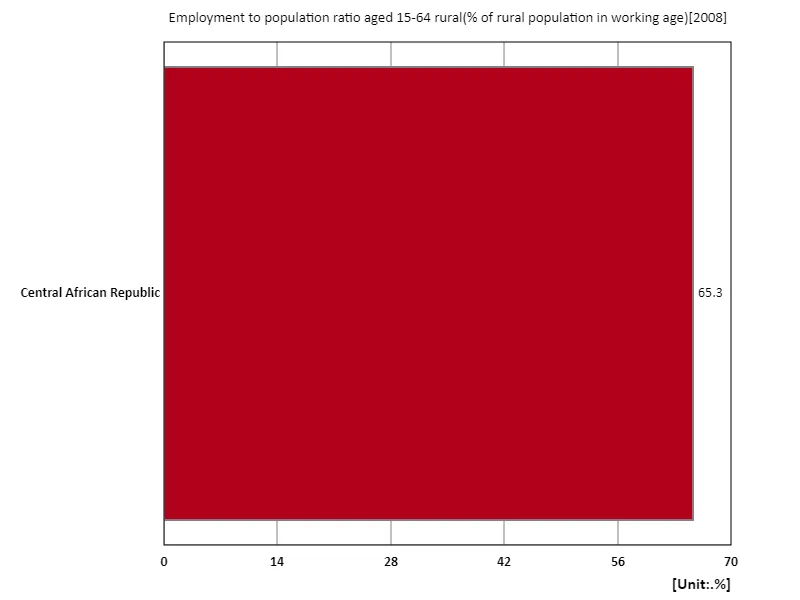- Abstract
- Ages 15-64, rural employment rate (ratio of rural population of working age)
- Employment rate in rural areas (ratio of working-age rural population) for ages 15-64 (Worldwide)
- Employment rate in rural areas (ratio of rural population of working age) for ages 15-64 (World, latest year)
- Ages 15-64, rural employment rate (ratio of rural population of working age) (region, latest year)
- Reference
Abstract
Employment rate data shows the proportion of employed people in relation to the working-age population and can help gauge the health of the economy and the state of the labour market. In 2021 data, Peru recorded the highest employment rate at 74.7%. This could signal success in Peru’s economic growth and job creation. Over the past few decades, employment rates have varied widely across countries, but some countries have maintained high employment rates due to economic growth and policies. On the other hand, employment rates can be low in countries with economic recession or structural problems. A country with high employment rates, such as Peru, reflects efficient labor markets and strong economic activity, and sustainable growth strategies and labor market reforms are important to maintain this.
Ages 15-64, rural employment rate (ratio of rural population of working age)
Looking at data from 1974 to 2021, Thailand’s employment rate peaked at 84.3% in 1989, and although it declined temporarily thereafter, it has now returned to a high level of 86.9%. The fluctuations reflect changes in Thailand’s economic growth and labor market. In the late 1980s and early 1990s, Thailand experienced rapid industrialization and economic development, resulting in a peak in employment rates. However, there was a temporary decline after that due to the Asian currency crisis, economic maturity, structural reforms, and other factors. Nevertheless, the recent recovery is evidence of Thailand’s economic stability and growth, and is likely a result of the government’s labour market policies and economic strategies. In particular, industrial diversification, improved educational standards, and increased employment opportunities have contributed to this, and efforts toward sustainable job creation are important.


The maximum is the latest one, 92.6% of Peru
Employment rate in rural areas (ratio of working-age rural population) for ages 15-64 (Worldwide)
Based on data spanning 1974 to 2021, Thailand’s employment rate peaked at 84.3% in 1989. The high employment rate during this period is due to Thailand’s rapid economic growth and industrialization. The employment rate subsequently declined temporarily due to events such as the Asian financial crisis (1997), but Thailand has since recovered through economic diversification and policy reforms. The current employment rate of 86.9% is above its peak, indicating labor market stability and economic health. This is believed to be due to the Thai government’s labor market policies, investment in education, and industrial sophistication. To maintain high employment rates, sustainable growth strategies and labour market reforms are needed going forward.


The maximum is the latest one, 92.6% of Peru
Employment rate in rural areas (ratio of rural population of working age) for ages 15-64 (World, latest year)
According to 2021 data, Peru recorded the highest employment rate for the working-age population aged 15-64 at 74.7%, while the overall average was 61.3%. Peru’s high employment rate is a result of its growing economy and expanding labor market, particularly as it develops as an emerging market. The average of 61.3% reflects the difference between developed and developing countries, where different economic conditions and policies affect employment rates. In addition, the total figure of 981% is a combination of data from each country, and can be used as a reference when looking at the economic situations of different countries. Historically, employment rates have risen in some countries as a result of economic growth and policies, while in other countries they have stagnated due to economic problems or structural challenges in the labor market. Sustained growth strategies and policy flexibility are key to improving the labor market.


The maximum is 92.6% of Peru, the average is 63.1%, and the total is 946%
Ages 15-64, rural employment rate (ratio of rural population of working age) (region, latest year)
According to 2008 data, the Central African Republic has the highest rural employment rate at 65.3%, a figure that is similar to the overall average and total. This situation indicates that the rural economy is mainly dependent on agriculture. Especially in countries like the Central African Republic, agriculture is a major source of employment and many people in rural areas depend on it for their livelihood. However, the figure of 65.3% means that while rural employment has a certain stability, it also lacks quality and diversity. In rural areas, work is seasonal and sensitive to weather and market fluctuations. This can put job security at risk. Additionally, as rural areas are increasingly moving to cities, young people are increasingly moving to cities in search of better employment opportunities. Given this background, improving agricultural productivity and fostering diverse industries are necessary to increase employment rates in rural areas. In addition, there is a call to promote sustainable development of local economies through strengthening education and skills training. Overall, employment rates in rural areas are high, but improving quality and building a stable economic base remain key challenges.


The maximum is 65.3% of Central African Republic, the average is 65.3%, and the total is 65.3%



Comments